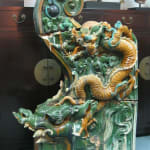A Pair of Ming Dynasty Glazed Dragon Temple Tiles, 1368 CE - 1644 CE
Ceramic
32.2 x 47.6 x 9.8
DL.2078A
Further images
Glazed sculptural tiles are today considered one of the hallmarks of classical Chinese architecture. However, despite their popularity in modern times, they were relatively scarce until after the end of...
Glazed sculptural tiles are today considered one of the hallmarks of classical Chinese architecture. However, despite their popularity in modern times, they were relatively scarce until after the end of the Tang Dynasty. Even then, during the Song and Yuan Dynasties, they were still infrequently used. It was not until the rise of the Ming Dynasty that glazed sculptural tiles became a popular decorative device extensively employed in temples, altars, imperials palaces, and gardens. Beijing became the center of glazed architectural tile production during the Ming period, and colorfully decorated pagodas began to sprout up around this region. Eaves and entryways were decorated with vibrant sculptures that served both decorative and sometimes religious purposes. On temples and palaces, representations of mounted warriors and snarling dragons were meant to ward off evildoers, of both the physical and spiritual kind.
This fantastic pair would have been one of the centerpieces in the decorative scheme of a Ming Dynasty temple. Brilliantly colored in emerald green, turquoise and ochre hues, the tiles each depict two snarling dragons against a background of swirling foliage. The shape of the tiles suggests that they would have been situated on the curved edge of a temple roof. With their open mouths, sharp fangs and beady eyes these dragons would surely have been most effective at guarding the sacred space from evil spirits. This pair is but one part of a larger scheme that would once have decorated the temple structure. When we imagine the entire edifice covered with such tiles, from the walls to the roof, the glory of Ming Dynasty China becomes apparent.
This fantastic pair would have been one of the centerpieces in the decorative scheme of a Ming Dynasty temple. Brilliantly colored in emerald green, turquoise and ochre hues, the tiles each depict two snarling dragons against a background of swirling foliage. The shape of the tiles suggests that they would have been situated on the curved edge of a temple roof. With their open mouths, sharp fangs and beady eyes these dragons would surely have been most effective at guarding the sacred space from evil spirits. This pair is but one part of a larger scheme that would once have decorated the temple structure. When we imagine the entire edifice covered with such tiles, from the walls to the roof, the glory of Ming Dynasty China becomes apparent.





